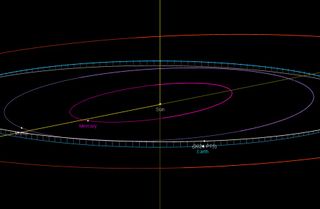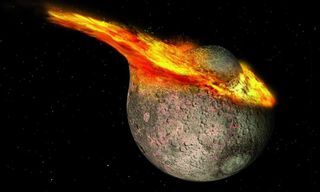Earth’s ‘second moon’ is visiting its cosmic parents for Thanksgiving
The “second moon” of the world will not be stuck for Thanksgiving, but just as many of us will do on Thursday (Nov. 28), it seems that the asteroid was visiting relatives.
An analysis of asteroid 2024 PT5, which will leave Earth on Monday (Nov. 25), made during its stay in orbit around our planet, shows that it may have been born from objects taken from our moon. the truth after one of the old conflicts that left the moon. surface pitted and finely scarred.
The leading theory of moon formation, called the “giant impact hypothesis,” suggests that Earth’s true moon was formed in the Titanic collision about 4 billion years ago. in the past it sprayed molten material from the Earth that eventually cooled and froze. This means that Earth is the ancestor of the “second moon,” or “young moon.”
“There is a lot of evidence that this asteroid may have a moon,” Carlos de la Fuente Marcos, lead author of the discovery and a professor at the Universidad Complutense de Madrid, told Space.com. “The latest research favors its rapid rotation with an orbital period of under one hour, which can be expected if 2024 PT5 is a large lunar rock or fragment of an object. it’s bigger.”
The young moon’s origin is also indicated by its appearance, which shows that its chemical composition closely matches the lunar materials brought to Earth by the Russian Luna missions and NASA’s Apollo moon missions.
How the Earth captured the small moon
The “mini-moon” asteroid is from the Arjuna asteroid belt, the second asteroid belt made up of space rocks that follows a solar orbit very similar to Earth’s orbit, located about 93 million (150 million kilometers). ) to the sun.
“Some objects in the Arjuna asteroid belt can approach Earth as close as 2.8 million kilometers (4.5 million miles) and at speeds as low as 2,200 kilometers per hour (3,540 km per hour ),” Marcos explained. “Asteroid 2024 PT5 will not explain the full orbit of the Earth. You might say that if a real satellite is like a customer shopping in a store, objects like 2024 PT5 are window shoppers.”

Small lunar events are divided into two categories: those with long periods of stay, during which an asteroid completes one or more orbits of our planet in a year or more, and interactions that short ones in which the small body does not complete it. full revolution. These later, some temporary ones last for days, weeks, or even a few months.
Marcos said that, in order for an asteroid to become a small moon, it would have to approach Earth at a distance of about 2.8 million kilometers (4.5 million miles) and at a speed of about 2,200 mph (3,540 km per hour), which is a relatively slow speed.
These conditions were reached by 2024 PT5 at 3:54 EDT (1954 UTC) on Sept. 29, 2024, which marks the beginning of a short arrest. The mission will end at 11:43 EDT (1543 UTC) on (Nov. 25), when disturbances caused by the sun’s gravity will disrupt its orbit.
When it leaves Earth, the asteroid will return to its welcome home in the Arjuna asteroid belt.

Marcos also said that, thanks to the abundance of astronomy obtained from the Teide Observatory, the determination of the 2024 PT5 orbit has been greatly improved. That means it is now widely known that NASA can study this object using radar when it approaches Earth on January 9, 2025.
But they are not the only scientists who have learned about this small moon so far. As mentioned, several papers have shown that, before it was received by the Arjuna asteroid belt, 2024 PT5 was a child of the moon, created when an asteroid hit the moon and caused material to be ejected. These findings may also suggest that some bodies in the Arjuna asteroid belt are from the moon.
“In the case of a lunar ejecta scenario, 2024 PT5 may be a large lunar rock that was ejected into the cislunar region after a cratering event, which was violently moved into orbit by in the middle of Arjuna’s asteroid belt,” Marcos said. “This object helped the community realize that the moon may be the main source of material that makes up the Arjuna asteroid belt.”
“In fact I will not be sad to see 2024 PT5 go; the little moons come and go as they wish. I’m just waiting for the next one,” Marcos concluded. “That wait won’t last long; the next capture will probably happen in the next few months. The ongoing Near Earth Object surveys now have enough sensitivity to pick up these objects always “.
Marcos is one of the authors of a new paper on 2024 PT5 and its properties that has been accepted for publication in the journal Astronomy & Astrophysics and is available in the preprint repository arXiv.
#Earths #moon #visiting #cosmic #parents #Thanksgiving